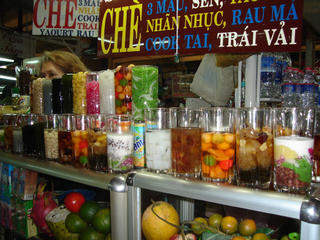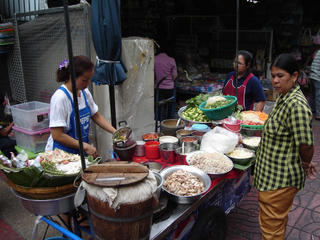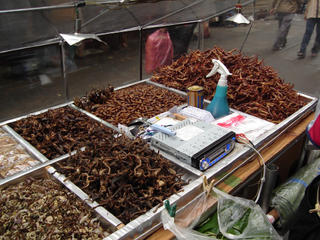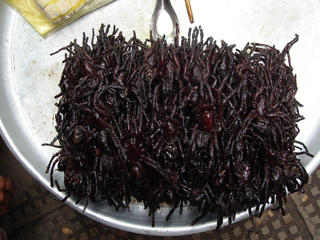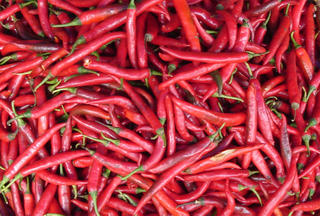Here are a few more pictures of random things from my trip. I hope you enjoy them.
Tuesday, September 20, 2005
Thursday, September 15, 2005
Street Food
One of the reasons that SE Asia is so cheap is that it is literally possible to eat for $2 per day. This is accomplished by eating at street stalls, carts, bicycles, and even baskets. Entire restaurants were carried around by old women in two baskets suspended from the ends of a bamboo pole.
While I did eat at street stalls in all four of the countries (Vietnam, Cambodia, Thailand, and Malaysia) I went to, I can really only compare the first three since I was only in Malaysia for three days and only ate at one street stall.
Vietnam, by far, had the best street food. The was an infinite variety and it changed from city to city. Each region and town had its own specialties. Dishes ranged from fried pancakes with shrimp and pork in them in Hoi An to cold noodle soups in the vegetable markets of Hanoi. In Ho Chi Minh City, which experienced heavy American influence during the war, it was possible to get a Vietnamese style sandwich. There are also a variety of mysterious things wrapped in banana leaves which have been steamed. I have no idea what most of them were, and most of them didn't taste all that good anyway.
Thailand, unlike Vietnam, has numerous curries which can be selected and poured over rice. There is also the ever present pad-thai and spring rolls. Thai bar-b-que is also very common and cheap as well. In southern Thailand fried chicken is also very common, particularly at railroad stations where you have just enough time to hop off the train, buy something, and jump back on before the train leaves again.
Cambodia is an interesting blend of Thai and Vietnamese. There are the curries, but there are also lighter dished more typical of Vietnam.
In all three countries smoothie stands have become very common in response to tourists. There are a variety of fruits from the normal apple and banana to more exotic things like dragon fruit. Fruit, ice (some places even have "safe" ice), and condensed milk are blended thoroughly. The smoothly is then put into a plastic bag which is sealed shut with a straw sticking out of it using a rubber band. This bag is then put into another plastic bag that has ice in it and handles so that you can carry your beverage. It really is a genius system and an excellent mid-day snack for about $0.20.
On of the most important things to know about eating street food is how to pick where to eat. They all appear similar at first, but a closer inspection is a must before deciding where to eat.
 Bar-b-qued pork (I think) wrapped into a spring roll on a side walk in Hoi An.
Bar-b-qued pork (I think) wrapped into a spring roll on a side walk in Hoi An.
 Cao Lao, the fried pancake things in the font, at a food stall in the market in Hoi An.
Cao Lao, the fried pancake things in the font, at a food stall in the market in Hoi An.
While I did eat at street stalls in all four of the countries (Vietnam, Cambodia, Thailand, and Malaysia) I went to, I can really only compare the first three since I was only in Malaysia for three days and only ate at one street stall.
Vietnam, by far, had the best street food. The was an infinite variety and it changed from city to city. Each region and town had its own specialties. Dishes ranged from fried pancakes with shrimp and pork in them in Hoi An to cold noodle soups in the vegetable markets of Hanoi. In Ho Chi Minh City, which experienced heavy American influence during the war, it was possible to get a Vietnamese style sandwich. There are also a variety of mysterious things wrapped in banana leaves which have been steamed. I have no idea what most of them were, and most of them didn't taste all that good anyway.
Thailand, unlike Vietnam, has numerous curries which can be selected and poured over rice. There is also the ever present pad-thai and spring rolls. Thai bar-b-que is also very common and cheap as well. In southern Thailand fried chicken is also very common, particularly at railroad stations where you have just enough time to hop off the train, buy something, and jump back on before the train leaves again.
Cambodia is an interesting blend of Thai and Vietnamese. There are the curries, but there are also lighter dished more typical of Vietnam.
In all three countries smoothie stands have become very common in response to tourists. There are a variety of fruits from the normal apple and banana to more exotic things like dragon fruit. Fruit, ice (some places even have "safe" ice), and condensed milk are blended thoroughly. The smoothly is then put into a plastic bag which is sealed shut with a straw sticking out of it using a rubber band. This bag is then put into another plastic bag that has ice in it and handles so that you can carry your beverage. It really is a genius system and an excellent mid-day snack for about $0.20.
On of the most important things to know about eating street food is how to pick where to eat. They all appear similar at first, but a closer inspection is a must before deciding where to eat.
- Are locals eating there? The locals know the best places to eat, just like you do when you are at home.
- How clean is the place? Remember that cleanliness is a relative concept, so don't expect Martha Stewart's kitchen, but just check to see that there aren't flies all over the food.
- Is there active food preparation going on? Don't eat at places at 4 in the afternoon where it looks like the food was originally cooked at 9 in the morning.
- If there are only tourists at the stall, do not eat there.
- If there is not a sign with a price, negotiate the price first. Expect to pay a little more than the locals, but do not get completely ripped off.
- Take it easy with the chili sauce. It is a lot stronger than you think it will be.
- Take pepto-bismol. It can't hurt.
 Bar-b-qued pork (I think) wrapped into a spring roll on a side walk in Hoi An.
Bar-b-qued pork (I think) wrapped into a spring roll on a side walk in Hoi An. Cao Lao, the fried pancake things in the font, at a food stall in the market in Hoi An.
Cao Lao, the fried pancake things in the font, at a food stall in the market in Hoi An.Saturday, September 10, 2005
Silk
Hoi An in Vietnam is famous for its tailors as well as the architecture which was a result of the large Chinese trading guilds in the 18th and 19th centuries. Because there are dozens of tailors, shop[s often try to find a gimmick to get you into their shop. One of the best I found was a place that produced its own silk and had all the steps laid out so that you could see the entire process from start to finish.
The process starts with silk worms. The silk worms are placed in large flat baskets with chopped up mulberry leaves. The worms stay in the basket for about 19 days eating and they grow to about 2 inches long and are as thick as sharpie marker.

After they worms have reached full size they are placed onto a frame full of mulberry branches and the worms spin a silk cocoon and go to sleep to turn into moths. They stay on the branches for about 4-5 days.
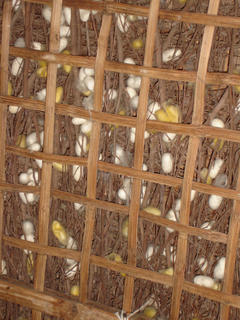
After the 4-5 days the cocoons are divided into two groups. The first group is put into cages and allowed to fully mature into moths. These moths eventually lay eggs, which serve as the next generation of worms to continue the process. The other group of cocoons are taken into another room to collect the silk.

15 of the cocoons are placed into water that is kept at exactly 82 degrees. Small threads of silk are removed from each cocoon. These 15 threads are combined into a single thread and this thread is wound up around a large spool. This is the hardest part of the process and the women who do it are very skilled. They have to turn the machine at just the right rate to get the 15 threads to form a single thread and to insure that the thread cools enough by the time it gets wound onto the spool so that the threads do not stick together. The 15 cocoons can make a single thread more than 500 m long.

Eventually the threads of silk are taken to another room and put on a loom and turned into silk fabric. It can then be dyed and made into just about anything you can think of.
The process starts with silk worms. The silk worms are placed in large flat baskets with chopped up mulberry leaves. The worms stay in the basket for about 19 days eating and they grow to about 2 inches long and are as thick as sharpie marker.

After they worms have reached full size they are placed onto a frame full of mulberry branches and the worms spin a silk cocoon and go to sleep to turn into moths. They stay on the branches for about 4-5 days.

After the 4-5 days the cocoons are divided into two groups. The first group is put into cages and allowed to fully mature into moths. These moths eventually lay eggs, which serve as the next generation of worms to continue the process. The other group of cocoons are taken into another room to collect the silk.

15 of the cocoons are placed into water that is kept at exactly 82 degrees. Small threads of silk are removed from each cocoon. These 15 threads are combined into a single thread and this thread is wound up around a large spool. This is the hardest part of the process and the women who do it are very skilled. They have to turn the machine at just the right rate to get the 15 threads to form a single thread and to insure that the thread cools enough by the time it gets wound onto the spool so that the threads do not stick together. The 15 cocoons can make a single thread more than 500 m long.

Eventually the threads of silk are taken to another room and put on a loom and turned into silk fabric. It can then be dyed and made into just about anything you can think of.
Wednesday, September 07, 2005
Tuesday, September 06, 2005
Same, Same... But Different
As a traveler from the United States there are quite a few familiar things in SE Asia. You can find McDonalds, Burger King, and especially 7-11 in Thailand. I even saw a couple KFCs in Ho Chi Minh City.
There are also numerous consumer products that can be found here at home and also in SE Asia. Coca Cola, the globally ubiquitous beverage is the first that comes to mind, but there are other as well. Some that are not totally expected. It is also interesting to see very familiar packaging in a completely different set characters. Take this Gatorade bottle for instance. On one side you have a sight that is the same as any in any 7-11 in the United States.

However, if you turn the bottle around you will find the exact same label design, but something is a little different.

There are also numerous consumer products that can be found here at home and also in SE Asia. Coca Cola, the globally ubiquitous beverage is the first that comes to mind, but there are other as well. Some that are not totally expected. It is also interesting to see very familiar packaging in a completely different set characters. Take this Gatorade bottle for instance. On one side you have a sight that is the same as any in any 7-11 in the United States.

However, if you turn the bottle around you will find the exact same label design, but something is a little different.

Sunday, September 04, 2005
Friday, September 02, 2005
Banisters
For some reason, throughout time the people living in Vietnam have clearly never been happy with the idea of simply having a simple rounded banister to accompany a flight of stairs. They are much more keen on complex, intricately carved, stylized dragons. They vary from the bulbously cartoonish to the fiercely theatrical. Sometimes they are partially painted as well.
The Cambodians also seem to be opposed to bland undecorated banisters. But unlike the Vietnamese dragons, the Cambodians greatly favor the mythological seven-headed Naga.
The Cambodians also seem to be opposed to bland undecorated banisters. But unlike the Vietnamese dragons, the Cambodians greatly favor the mythological seven-headed Naga.
Wat Phnom, Phnom Penh
Subscribe to:
Comments (Atom)






